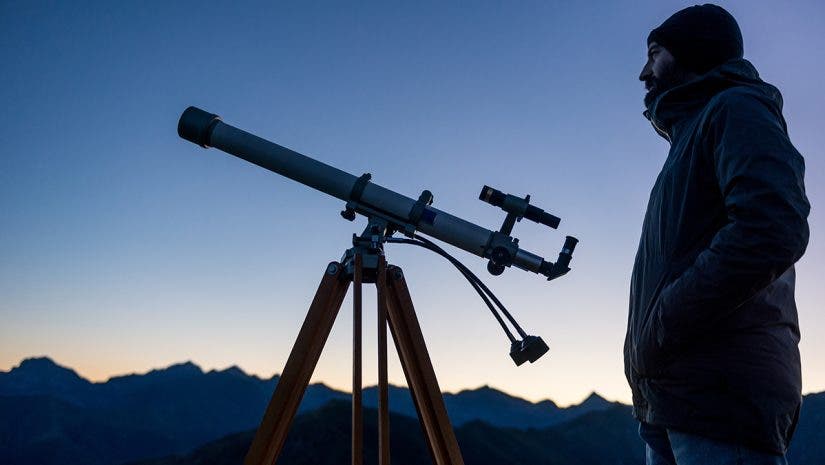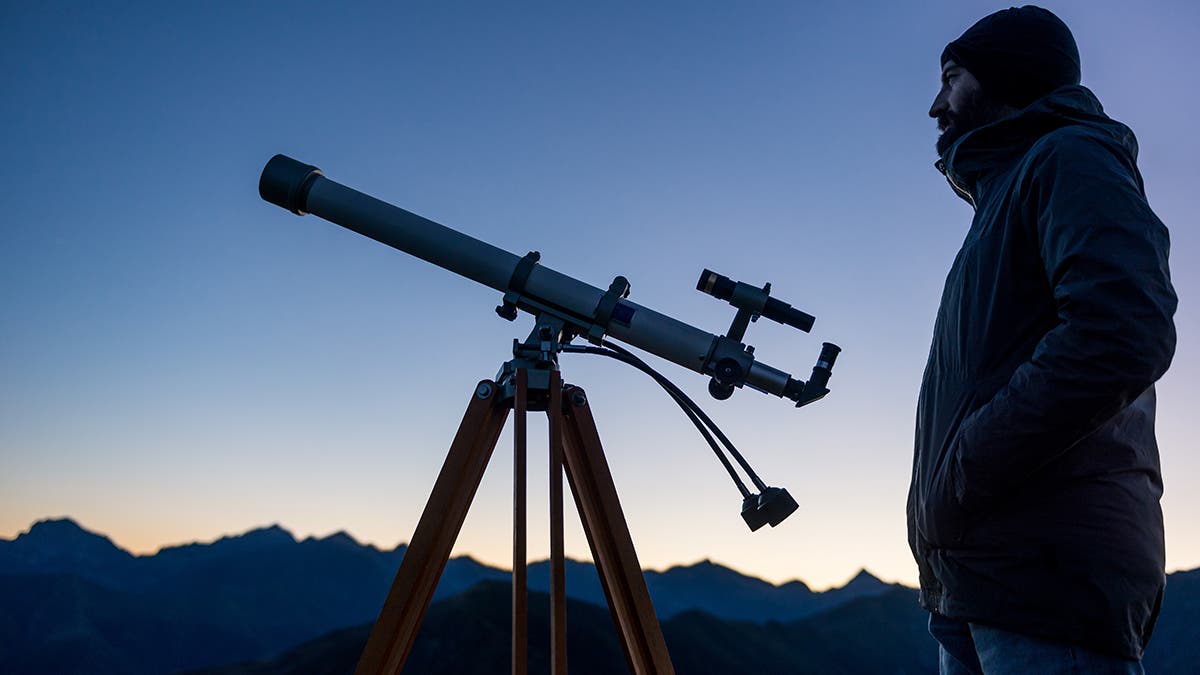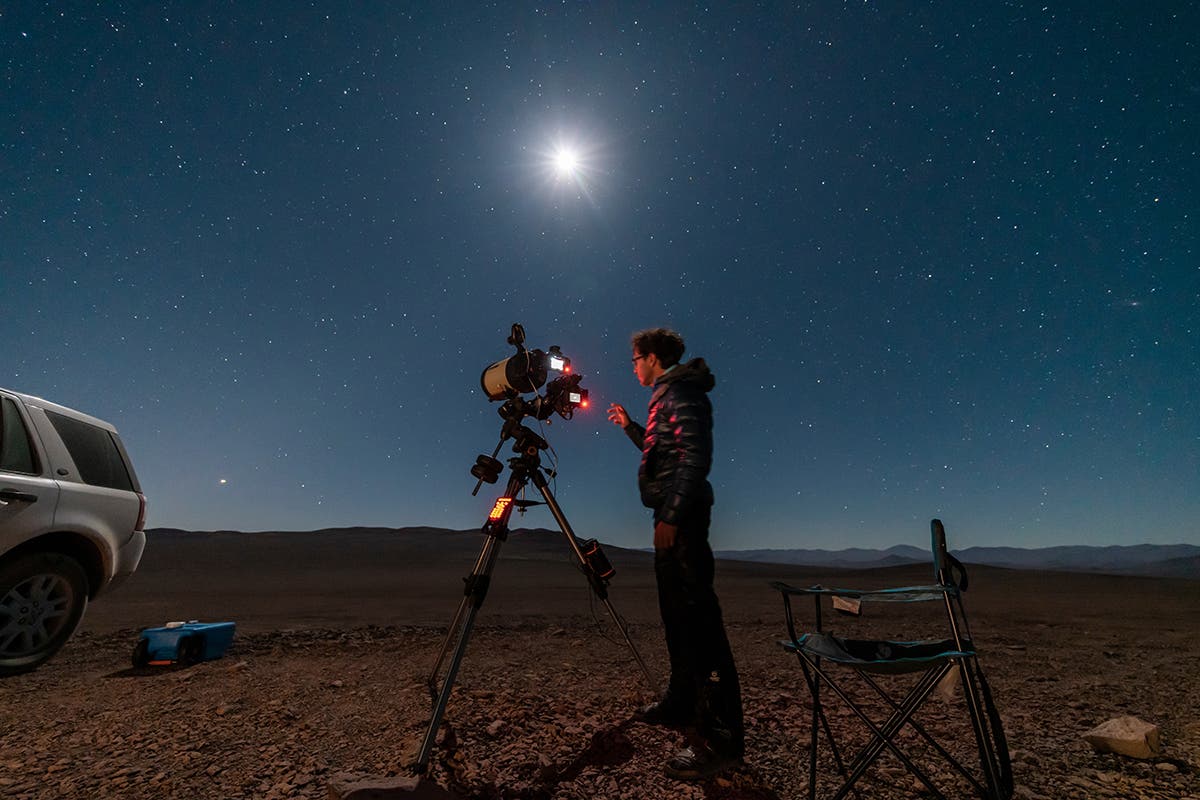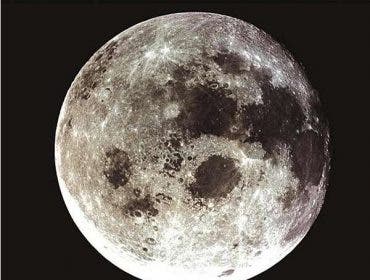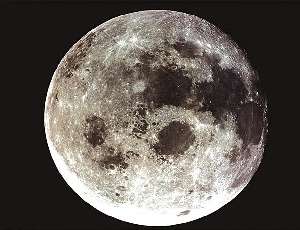Viewing the heavens through a telescope is a breathtaking venture that will leave you with life-long memories. But before you can have that experience, you must do something more down to earth: buy a telescope. Choosing your first telescope can be a scary task. This beginner’s guide to telescopes will teach you about the different kinds of telescopes, how they work, and how to choose the right one for you.
Four Questions to Ask Before Choosing Your Telescope
Where will I be viewing?
In a city setting or in larger towns there are many street and building lights. These lights give off a glow that causes a light dome. This light dome effects what you see at night by casting a bright haze that blocks out the fainter stars, galaxies and nebulas. City dwellers are mostly limited in viewing solar, Luna, planetary, double stars, and some of the brighter deep sky objects. A telescope with an aperture from 3.0” to 8” should suit them fine.
All telescopes work well away from the city. There, light pollution does not limit your choices. The larger aperture scopes, 8” and greater, will give you unbelievable views of nebulas, galaxies, and star clusters.
What objects do I want to view?
Astronomy is a broad hobby with many fields of interest. Amateur astronomers can help in the research of Solar, Luna, planetary and variable star studies. Amateurs can also conduct nova, supernova, comet and minor planets searches. Or, you can do it just for the fun and love of viewing and imaging the heavens. Gear your telescope purchase around your interest.
What is my budget?
Telescope pricing can range from $99 for a small refractor to over $20,000 for a large 16” catadioptric telescope. Buy what you can afford, or save up and get it later.
How much do am I willing to carry?
The size and weight of the telescope you are willing to carry is probably the biggest problem one must ponder. Telescopes can range from around 15 lbs. to well over 300 lbs. Most can be broken down into 3 subsections for transportation: the optical tube assembly, the telescope mount, and the tripod or base. Remember, if the scope is too heavy, you may not use it at all!
Learn about Aperture
The aperture of the telescope is its heart. The diameter of the aperture determines the light gathering ability of the scope. When you increase the size of the aperture from a 4” to an 8” you increase the resolving power by a factor of two and the light gathering power by a factor of four. For example, 4” telescope at a 120x will just show M13 (star cluster) as a fuzzy spot, but when viewed with an 8” using the same magnification M13 is resolved to its core showing hundreds of stars. Larger aperture telescopes are better when seeing conditions are good in showing fine detail in planets, Luna and deep sky objects.
Beginner’s Guide to Telescope Designs
Refractor Telescopes

The refracting telescope has a good rugged design and is mostly maintenance free. They can consist of two, three or four glass lens elements that bend the light until it is focused at the far end of the tube. Their closed tube systems protect the optics from dust and air currents. Higher quality refractors give beautiful views with pinpoint stars images. Refractors are great for viewing and imaging double stars, planets, lunar, solar, comets and the brighter deep sky objects.
Advantages:
- Pinpoint star images,
- No central obstruction
- True color correction on the higher end two, three and four-element versions
- Excellent for astro-imaging
- Sealed from dust and dirt
Disadvantages:
- Chromatic aberration on the lower end two element telescopes
- High cost on instruments over 5” due to rare exotic glasses used
Here are examples of refractor telescopes:
Reflector Telescopes
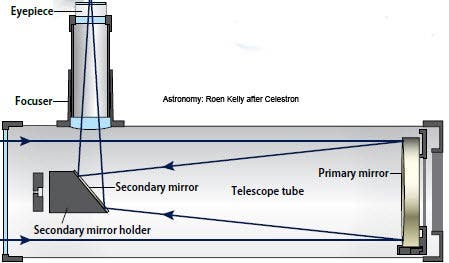
The reflecting telescope is very simple in design, using two mirrors to direct the incoming light into the eyepiece. They are very cost effective per aperture size compared to other telescopes. Reflectors are good for deep sky, planetary, Luna and astro-imaging.
Advantages:
- Low Cost
- Excellent color correction
- Free of chromatic aberration
Disadvantages:
- Open tube, dust and dirt can accumulate on the mirrors
- Air currents
- Central obstruction
- Shorter Focal Lengths suffer from coma
- Very long tube size in higher focal lengths
- Mirrors misalignments
- Collimation of optics
Here are examples of reflector telescopes:
Catadioptric (Compound) Telescopes
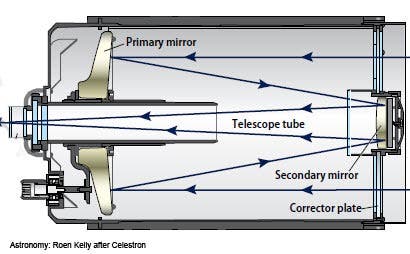
Catadioptric telescopes have closed tubes. This keeps the optical system clean of dust and dirt. Air currents are also kept to a minimum in this design and these telescopes are very portable. The optical system is a combination of mirrors plus a lens system, resulting in a compact optical tube assembly. The Catadioptric telescopes are good for all types of astronomical viewing and imaging.
Advantages:
- Closed Tube
- Compact, portable design
- Free of chromatic aberration
- Coma free on some models
Disadvantages:
- Central obstruction
- Mirror flop on some models
- Long cool down time
Here are examples of catadioptric telescopes:
Magnification
The magnification (power) of a telescope is variable and depends upon the eyepieces one uses. The power is computed by dividing the focal length of the primary objective (aperture) of the telescope by the focal length of the eyepiece being used. Example; an Celestron 8” f/10 SCT has a focal length 2032mm divide this by a 10mm eyepiece comes to a power of 203x.
Types of Mounting Systems
There are several types of mounting systems that telescopes use and can be purchased with.
Alt-Azimuth Mount
A simple mount that moves up and down in altitude and left and right in azimuth. These mounts are lighter than equatorials and are very easy to use.
Here is an example of an Alt-Azimuth mount:
Equatorial Mount
Allows the telescope to move in the celestial north-south and in the east-west axis. If the mount is properly aligned to the polar axis, you can track celestial objects across the sky. Many of the modern equatorial mounts come with motors and GoTo computer systems. Examples are the Celestron VX mount and the Ioptron GoTo mount.
Before you purchase a telescope, we recommend attending a local astronomy club meeting; they are a very good source of information, and members will let you view through their telescopes. Go to local astronomy events and star parties—amateur astronomers love to show the sky to the public! Go out and view the beauty of the night sky.
Here is an example of an equatorial mount:
This post was originally published on July 8, 2018, and later updated.
